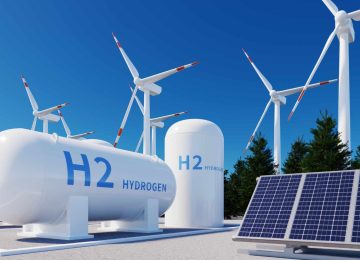The global tech sector’s carbon emissions are significantly rising, primarily fueled by the rapid expansion of artificial intelligence (AI) and its underlying data infrastructure.
This warning comes from the latest “Greening Digital Companies 2025” report, a collaborative effort by the International Telecommunication Union (ITU), a UN agency, and the World Benchmarking Alliance (WBA).
The report, which tracked the carbon footprint of 200 prominent digital firms, highlights a critical disconnect between ambitious ESG targets set by many tech companies and their actual operational impact. While companies often publicize their commitment to sustainability, the surge in AI and cloud computing is outpacing efficiency gains, leading to a net increase in their emissions.
Operational emissions (both Scope 1 and Scope 2) from four major AI-focused tech giants have surged by an average of
150% since 2020. This alarming increase highlights the urgent need to manage AI’s growing environmental impact, the
authors say.
AI expansion drives energy demand.
According to ITU, the core issue is the escalating electricity consumption of data centers, which power AI development.
From 2017 to 2023, data center electricity use increased by 12% annually. This rate is four times faster than global electricity growth. In 2023, the 164 digital companies reporting electricity consumption accounted for 2.1% of global electricity use, or 581 terawatt-hours (TWh). Ten companies alone were responsible for half of this total. Overall, the GHG emissions from 166 digital companies contributed 0.8% of all global energy-related emissions in 2023.
Doreen Bogdan-Martin, Secretary-General, ITU, said, “Advances in digital innovation — especially AI — are driving up energy consumption and global emissions.” She urged the industry to shrink its footprint and sustain momentum in addressing this challenge.
Lourdes O. Montenegro, Director, Research and Digitization, WBA, emphasized that “progress must be measured not only by ambition, but by credible action.”
Progress amidst rising challenges:
Despite the rise in emissions, the report highlights encouraging progress in transparency and accountability.
Eight companies scored over 90% in climate commitment assessment, up from three last year.
Almost half of assessed companies have committed to achieving net-zero emissions, with 51 targeting earlier deadlines
than 2050.
Renewable energy adoption is increasing, with 23 companies operating on 100% renewable energy in 2023, up from 16
in 2022.
More companies are releasing dedicated climate reports (49 firms).
The number of companies publishing Scope 3 emissions targets (indirect emissions from supply chains and product use) rose significantly, from 73 to 110. This signals greater awareness of broader industry impacts.
Call for collaborative action:
The report issues a strong call for bold and immediate action. It recommends that companies must:
- Strengthen data verification, target ambition, and climate reporting, including publishing climate transition action plans.
- Disclose the full environmental footprint of their AI operations.
- Foster cross-sector collaboration among tech firms, energy producers, and environmental advocates.
- Continue to accelerate renewable energy adoption.
Cosmas Luckyson Zavazava, Director, Telecommunication Development Bureau, ITU, said, “Despite the progress made, greenhouse gas emissions continue to rise, confirming that the need for digital companies to adopt science-aligned, transparent, and accountable climate strategies has never been greater. ITU’s work in monitoring the environmental impact of the sector is a crucial step towards achieving a sustainable digital transformation.”
Soaring energy demand from AI data centers:
The core of the problem lies in the burgeoning energy consumption of data centers, the foundational infrastructure for AI development and deployment.
The ITU report, corroborated by findings from the International Energy Agency (IEA), indicates that electricity consumption by data centers has been growing at an annual rate of 12% since 2017—a pace four times faster than overall global electricity growth.
By 2023, data centers alone consumed 415 terawatt-hours (TWh) of electricity, representing 1.5% of global power demand. Projections suggest this could soar to 945 TWh by 2030, surpassing Japan’s entire annual electricity consumption.
Four of the leading AI-focused tech companies—Amazon, Microsoft, Meta, and Alphabet—experienced particularly significant increases in their operational carbon emissions (including both direct Scope 1 and purchased energy Scope 2 emissions) between 2020 and 2023:
Amazon: 182% increase
Microsoft: 155% increase
Meta: 145% increase
Alphabet (Google): 138% increase
These figures primarily represent indirect emissions from the vast amounts of purchased electricity required to power their massive data infrastructures.
The total GHG emissions reported by 166 of the 200 digital companies in 2023 amounted to 297 million tons of carbon dioxide equivalent, a volume comparable to the combined annual emissions of Argentina, Bolivia, and Chile.
Policy vacuum and the path forward:
A significant concern highlighted by the UN agency is the current regulatory vacuum surrounding AI emissions. There are currently no standardized or legislative requirements for companies to disclose their AI emissions or specific energy consumption related to AI workloads. This lack of transparency makes it challenging to fully comprehend and manage the environmental impact of AI.
According to Doreen Bogdan-Martin, “Advances in digital innovation—especially AI—are driving up energy consumption and global emissions.”
She emphasized that while these innovations mark dramatic technological breakthroughs, unchecked emissions from top-emitting AI systems could soon reach 102.6 million tons of carbon dioxide equivalent per year.
Despite the alarming trends, the report also notes some positive developments. There’s a growing understanding within the industry of the challenge.
Transparency is improving, with more companies issuing standalone climate reports and setting targets for indirect Scope 3 emissions related to their supply chains and product use.
Some tech companies are also actively investing in renewable energy solutions, with some, like Microsoft and Amazon, even exploring nuclear power to meet the immense, round-the-clock power demands of their data centers, acknowledging the intermittency challenges of solar and wind alone.













